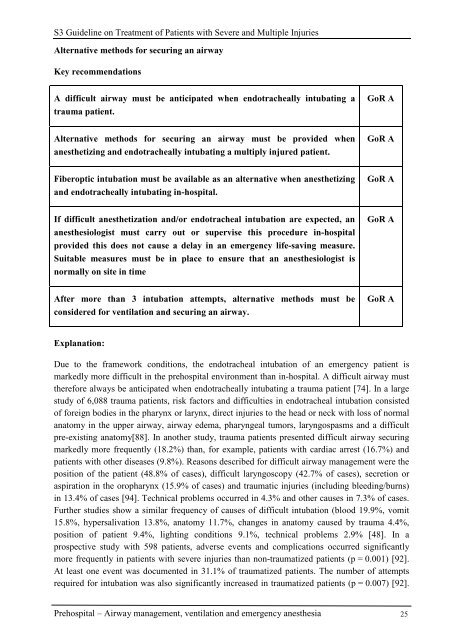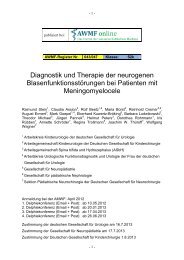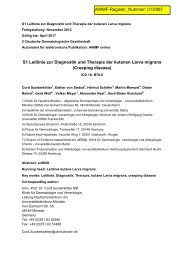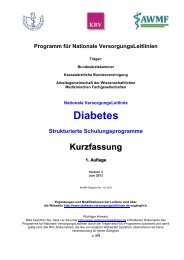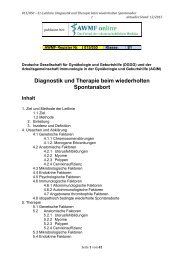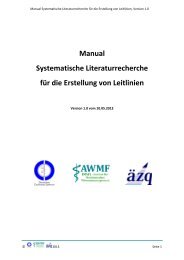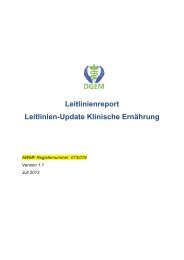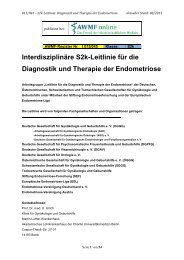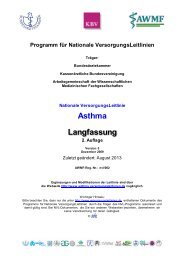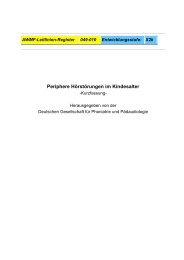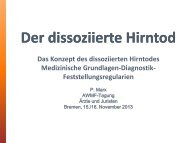Guideline on Treatment of Patients with Severe and Multiple ... - AWMF
Guideline on Treatment of Patients with Severe and Multiple ... - AWMF
Guideline on Treatment of Patients with Severe and Multiple ... - AWMF
You also want an ePaper? Increase the reach of your titles
YUMPU automatically turns print PDFs into web optimized ePapers that Google loves.
S3 <str<strong>on</strong>g>Guideline</str<strong>on</strong>g> <strong>on</strong> <strong>Treatment</strong> <strong>of</strong> <strong>Patients</strong> <strong>with</strong> <strong>Severe</strong> <strong>and</strong> <strong>Multiple</strong> Injuries<br />
Alternative methods for securing an airway<br />
Key recommendati<strong>on</strong>s<br />
A difficult airway must be anticipated when endotracheally intubating a<br />
trauma patient.<br />
Alternative methods for securing an airway must be provided when<br />
anesthetizing <strong>and</strong> endotracheally intubating a multiply injured patient.<br />
Fiberoptic intubati<strong>on</strong> must be available as an alternative when anesthetizing<br />
<strong>and</strong> endotracheally intubating in-hospital.<br />
If difficult anesthetizati<strong>on</strong> <strong>and</strong>/or endotracheal intubati<strong>on</strong> are expected, an<br />
anesthesiologist must carry out or supervise this procedure in-hospital<br />
provided this does not cause a delay in an emergency life-saving measure.<br />
Suitable measures must be in place to ensure that an anesthesiologist is<br />
normally <strong>on</strong> site in time<br />
After more than 3 intubati<strong>on</strong> attempts, alternative methods must be<br />
c<strong>on</strong>sidered for ventilati<strong>on</strong> <strong>and</strong> securing an airway.<br />
Explanati<strong>on</strong>:<br />
GoR A<br />
GoR A<br />
GoR A<br />
GoR A<br />
GoR A<br />
Due to the framework c<strong>on</strong>diti<strong>on</strong>s, the endotracheal intubati<strong>on</strong> <strong>of</strong> an emergency patient is<br />
markedly more difficult in the prehospital envir<strong>on</strong>ment than in-hospital. A difficult airway must<br />
therefore always be anticipated when endotracheally intubating a trauma patient [74]. In a large<br />
study <strong>of</strong> 6,088 trauma patients, risk factors <strong>and</strong> difficulties in endotracheal intubati<strong>on</strong> c<strong>on</strong>sisted<br />
<strong>of</strong> foreign bodies in the pharynx or larynx, direct injuries to the head or neck <strong>with</strong> loss <strong>of</strong> normal<br />
anatomy in the upper airway, airway edema, pharyngeal tumors, laryngospasms <strong>and</strong> a difficult<br />
pre-existing anatomy[88]. In another study, trauma patients presented difficult airway securing<br />
markedly more frequently (18.2%) than, for example, patients <strong>with</strong> cardiac arrest (16.7%) <strong>and</strong><br />
patients <strong>with</strong> other diseases (9.8%). Reas<strong>on</strong>s described for difficult airway management were the<br />
positi<strong>on</strong> <strong>of</strong> the patient (48.8% <strong>of</strong> cases), difficult laryngoscopy (42.7% <strong>of</strong> cases), secreti<strong>on</strong> or<br />
aspirati<strong>on</strong> in the oropharynx (15.9% <strong>of</strong> cases) <strong>and</strong> traumatic injuries (including bleeding/burns)<br />
in 13.4% <strong>of</strong> cases [94]. Technical problems occurred in 4.3% <strong>and</strong> other causes in 7.3% <strong>of</strong> cases.<br />
Further studies show a similar frequency <strong>of</strong> causes <strong>of</strong> difficult intubati<strong>on</strong> (blood 19.9%, vomit<br />
15.8%, hypersalivati<strong>on</strong> 13.8%, anatomy 11.7%, changes in anatomy caused by trauma 4.4%,<br />
positi<strong>on</strong> <strong>of</strong> patient 9.4%, lighting c<strong>on</strong>diti<strong>on</strong>s 9.1%, technical problems 2.9% [48]. In a<br />
prospective study <strong>with</strong> 598 patients, adverse events <strong>and</strong> complicati<strong>on</strong>s occurred significantly<br />
more frequently in patients <strong>with</strong> severe injuries than n<strong>on</strong>-traumatized patients (p = 0.001) [92].<br />
At least <strong>on</strong>e event was documented in 31.1% <strong>of</strong> traumatized patients. The number <strong>of</strong> attempts<br />
required for intubati<strong>on</strong> was also significantly increased in traumatized patients (p = 0.007) [92].<br />
Prehospital – Airway management, ventilati<strong>on</strong> <strong>and</strong> emergency anesthesia 25


